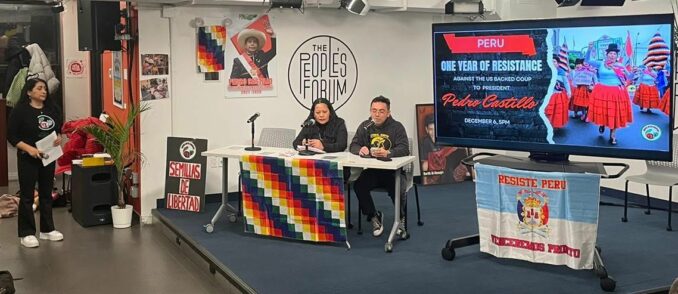Peruvians resist U.S.-backed coup
This talk was given at the “One Year of Resistance against the U.S.-backed Coup to Peruvian President Pedro Castillo” event, organized by PEX Semillas de Libertad and held Dec. 6 at People’s Forum in New York City and by Zoom.

‘One Year of Resistance’ against coup in Peru, People’s Forum, New York City, Dec. 6, 2023. Richie Merino at speakers’ table. Photo: Danny Shaw
Pedro Castillo, a former school teacher and farmer from an Andean backwater, was elected as the president of Peru in June 2021, with support from workers, campesinos and Indigenous people. He rose to power on a wave of popular anger at Peru’s hyper-corrupt establishment parties and promised radical change, particularly giving voice to Indigenous communities. Castillo recognized the importance of Indigenous communities in Peru – which include the Quechua, Aymara, Awajún, Conibo and Shipibo peoples, who had long been marginalized and unheard.
However, Castillo faced significant opposition from Peru’s political and business elite based in Lima. They could not accept that someone from a humble background could become the president. Despite being democratically elected, Castillo was overthrown in a U.S.-backed coup on December 7, 2022. The Peruvian Congress, under the influence of multinational corporations, carried out this coup against the legitimate president.
The de facto coup government led by Dina Boluarte responded to protests against the coup with brutal repression. More than 80 Peruvians have been killed, and thousands have been injured, detained or disappeared under the coup regime. Indigenous communities have been particularly targeted, facing physical attacks and extrajudicial executions.
The Boluarte government and Congress are widely despised by the Peruvian people. According to a March 2023 poll by the Institute of Peruvian Studies, Boluarte’s presidency has a disapproval rate of 78%, while the Congress has a disapproval rate of 91%. The government continues to block general elections, further fueling public discontent.
Today we mark one year of resistance to U.S. imperialism in Peru. Peruvians from all backgrounds, but especially Indigenous Peruvians, have been regularly marching against the unelected president, Boluarte, in support of Castillo, who they elected. They have participated in strikes and roadblocks to pressure the coup government to step down. However, they have been met with state-sanctioned violence. The protesters’ demands include the release of imprisoned Pedro Castillo, new general elections, a national referendum on forming a Constitutional Assembly and justice for the victims of the repression.
U.S imperialism behind coup
Pedro Castillo has condemned the U.S. Embassy in Peru for ordering the military to suppress anti-coup protesters. The U.S. ambassador to Peru at the time of the coup, Lisa Kenna, a veteran of both the CIA and U.S. State Department in Iraq, was an adviser to the coup plotters. It is likely that the U.S. played a direct role in removing President Castillo from power and installing Boluarte in his place to do the bidding of U.S. corporations.
The U.S. government’s interference in Peruvian democracy and self-determination is deeply troubling. The U.S. has sent over 1,200 uniformed troops with planes, ships, ammunition and communication equipment to support the unconstitutional coup government and to take control of Peru’s valuable resources, including lithium reserves. This militarization of Peru reflects U.S. imperialism’s global military domination, posing a threat to Peru’s national sovereignty.
The U.S. military collaboration with the Peruvian coup government constitutes endorsement of the repression and violence exercised by the Boluarte dictatorship against peaceful protesters. It sends a message of intimidation to social and political organizations in Peru that are calling for the restoration of democracy and the fairly elected government of Pedro Castillo.
Peru’s significant resources, including oil, gold, freshwater and lithium, have drawn the attention of the U.S. government. The U.S. is protecting its claims to these resources and views itself threatened by Peru’s growing relationship with China, its largest trading partner. Peru’s strategic position as a producer of lithium, copper, zinc and silver, crucial for renewable energy technologies, further amplifies the U.S. government’s interest in controlling the country.
The U.S. government’s actions in Peru reflect its intent to maintain economic and geopolitical dominance in the region. The former president of Bolivia, Evo Morales, who experienced a U.S.-backed coup in 2019, has warned about the consolidation of a repressive state and the impact on sovereignty and regional peace in Latin America.
It is evident that the U.S. government is not interested in building friendly bonds with the peoples of the American continents. Instead, it seeks to upgrade the Monroe Doctrine for the 21st century, with China and Russia as its strategic rivals. The situation in Peru highlights the need to support the Peruvian people in their struggle for self-determination, sovereignty and the protection of their natural resources.
Free President Pedro Castillo NOW!
U.S. troops OUT of Peru!
¡Boluarte, asesina, el pueblo no se inclina! (“Boluarte, murderer, the people won’t bow down!”)

